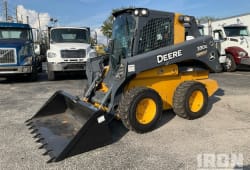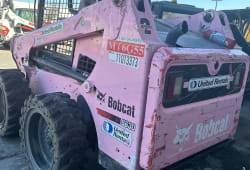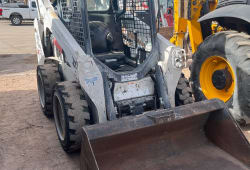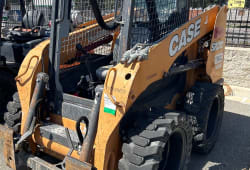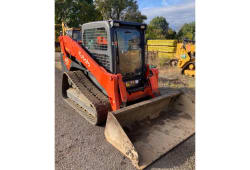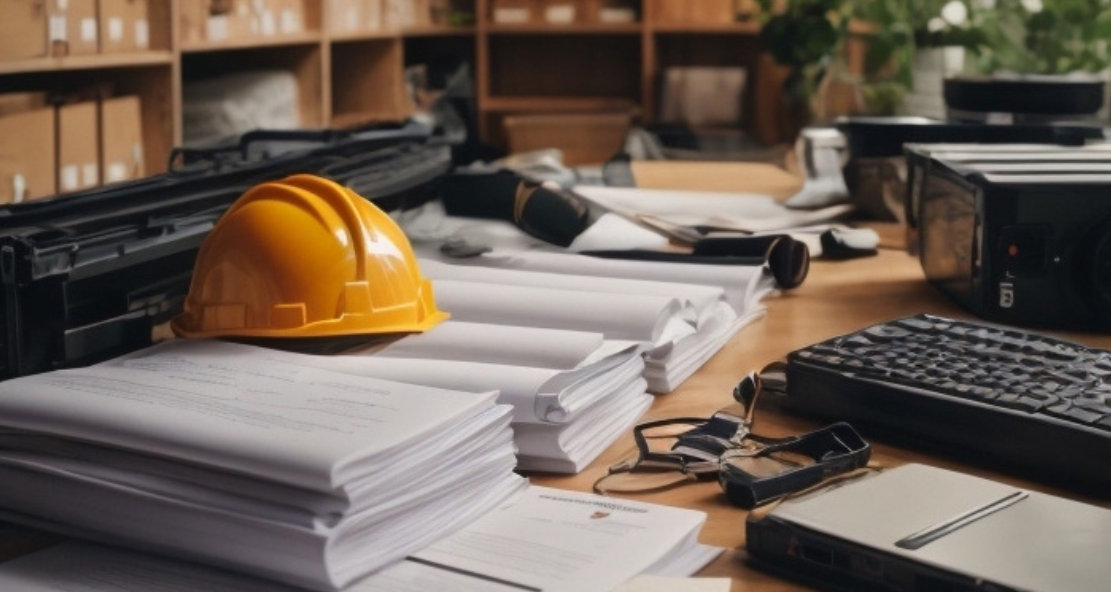Launch a Skid Steer Business in 5 Straightforward Steps
11 Lectura mínima
)
enero 6, 2022
Many people share the desire to start their own businesses - being their boss, controlling their agenda, and reaping the rewards of their hard work sounds appealing to almost everyone.
For heavy equipment operators, the know-how you already have places you in a top function to jump into going for walks on your operation. Skid steer loaders, mainly, are versatile machines with almost infinite possibilities to generate profits. There's usually a demand for skid steer services, whether or not it's for industrial production, residential projects, or landscaping paintings.
Running a skid steer business requires determination and effort, but it doesn't take a lot of advance funding to get started - particularly if you purchase a used skid steer. You also can scale your commercial enterprise at your tempo, growing as your workload increases and your crew expands.
Here's what you need to recognize to get started.
Step 1: Get enjoy.
Step 2: Make a marketing strategy.
Step 3: Incorporate.
Step 4: Acquire a skid steer.
Step 5: Get customers..
:format(webp)) Step 1: Get to Know Skid Steers - Make Yourself an Expert
Step 1: Get to Know Skid Steers - Make Yourself an Expert
How do you begin a Bobcat without a code? What about the best degreaser for heavy equipment? These are must-knows for skid steer owners and operators.
Suppose you don't take the time to become an expert skid steer operator. In that case, you may miss out on treasured enterprise opportunities, make luxurious errors at the process website, and lose profit to steeply-priced (preventable) repairs. You want to recognize how to turn out superb work correctly and effectively so that customers consider you their go-to.
There are numerous avenues to learn about skid steers usually. An aggregate of all of these strategies is the most fruitful method:
Network with skid steer operators
Take a class or training course dedicated to skid steers and heavy device businesses.
Get first-hand, on-the-activity web page training
A combination of those talent-boosting projects will help you avoid lessons that are difficult to learn and identify worthwhile possibilities others may overlook.
Step 2: Time to Talk Money - Make A Business Plan
:format(webp)) You need to map out a sports plan to ensure you are a commercial enterprise prepped to succeed. One of the new enterprise proprietors' most significant errors is over-spending, assuming that "it takes cash to make money" is the proper technique for every enterprise problem. Remember:
You need to map out a sports plan to ensure you are a commercial enterprise prepped to succeed. One of the new enterprise proprietors' most significant errors is over-spending, assuming that "it takes cash to make money" is the proper technique for every enterprise problem. Remember:
Income = Revenue - Expenses
Take the time to plan, set clear goals, and create detailed finance that debts for all of the curveballs you may stumble into. Most new businesses don't destroy even till a minimum of three years. How will you live to tell the tale until then? And what can you do to reduce charges on much less crucial costs so you can spend money on first-rate in which it counts?
:format(webp)) Here are just some startup prices to assume:
Here are just some startup prices to assume:
Business incorporation, licenses, and allows
Professional offerings (e.g., accountants and legal professionals)
Heavy equipment and various attachments (consider leasing or financing)
Safety necessities, which include PPE for crew individuals
Fuel and upkeep expenses
Transportation and garage fees
Taxes
While you're making your 5-year plan, remember that depreciation and preservation expenses are inevitable, so plan for them now.
:format(webp)) Pick the right rate point for your startup's services
Pick the right rate point for your startup's services
In the early days of starting your own business, you must charge your offerings at an amount that conveys that you do top-notch work while incentivizing new (capacity repeat) clients. As you prove yourself, you could continue to lose deals and, boom, your costs. It is a balancing act that takes some marketplace studies to best, wherein having made yourself a professional on skid steers pays dividends now.
An excellent e-book, The Lean Startup by Eric Ries, may help readers navigate the tightrope between startup fees and new business pricing.
Step 3: Make it Legit - Incorporation, Insurance, and Business Banking
:format(webp)) This is in which it receives real.
This is in which it receives real.
All of the planning and instruction now end with taking action. The first factor you want to do is to shape your commercial enterprise foundations. These are the stairs that separate the business from you as an individual. This is also in which the crew of ace professionals you budgeted for input the scene.
Most heavy device operators choose to form their company as a Limited Liability Company (or "LLC") because it's miles relatively easy and coffee-fee to hold and additionally limits the quantity that you because the enterprise owner can be, in my opinion, held liable must a person determine to sue over the paintings or a job-related injury. You'll need to run the business you want to create past an attorney because heavy device operation is a high-danger enterprise.
:format(webp)) Speaking of liability, enterprise coverage is crucial for jogging an enterprise built on a production gadget. You may not be able to get quality coverage until you offer documentation that your commercial enterprise has all the proper licensing and registrations, together with a contractor's license. (These varieties of licenses additionally assist you in building consideration in new customers and getting higher enterprise mortgage rates).
Speaking of liability, enterprise coverage is crucial for jogging an enterprise built on a production gadget. You may not be able to get quality coverage until you offer documentation that your commercial enterprise has all the proper licensing and registrations, together with a contractor's license. (These varieties of licenses additionally assist you in building consideration in new customers and getting higher enterprise mortgage rates).
Some common types of insurance encompass:
General Liability Insurance
Property & Equipment Insurance (Skid Steer Insurance and so on.)
Workers' Compensation
Business Auto Insurance
Umbrella Liability Insurance
Another crucial part of separating yourself as a character from the business operation is to separate your personal and business finances. Generally speaking, you do not want to "pierce the corporate veil" to mingle your cash. Skid steer earnings and fees must float through the business bank account. Make it clear while you are paying yourself out for offerings rendered and while you are creating a capital contribution to grow your organization. A satisfactory bookkeeper or bookkeeping software could make all the distinctions here.
Step 4: The Fun Part - Rent or Buy A Skid Steer Used or New
:format(webp)) Now it's time to get to the good stuff: lease or buy a skid steer loader. A first-rate skid steer is the backbone of your business model, so take some time to investigate which fashions have popularity for a protracted lifespan, low preservation costs, and user pride.
Now it's time to get to the good stuff: lease or buy a skid steer loader. A first-rate skid steer is the backbone of your business model, so take some time to investigate which fashions have popularity for a protracted lifespan, low preservation costs, and user pride.
You will also want to bear in mind:
How and in which will you store your skid steers
How you will transport your skid steers
The various jobs your skid steers will want to deal with
Smaller skid steers provide a compact length that is less expensive to shop and ship, while large skid steers offer the ability to lift heavier masses. How much will your skid steer weigh?
Remember that compact song loaders can provide a glad medium body with the electricity of larger fashions and the potential to be healthy in tight areas like a small frame skid steer.
:format(webp)) Popular skid steers and compact track loader options among commercial enterprise proprietors are:
Popular skid steers and compact track loader options among commercial enterprise proprietors are:
Once you've selected your skid steer setup, it's time to recall the one-of-a-kind attachments wished to complete jobs. The solution depends on whether or not you're doing excavation work, farm work, creation and landscaping initiatives, or different obligations.
Also, consider whether to hire or buy different production automobiles, such as trucks and trailers, to transport equipment between task websites.
With financing options available to lower your startup prices, shop skid steers, and skid steer attachments right here at Boom & Bucket. We have an extensive choice of trim-body skid steer options, massive skid steers, and a group ready to help you make a clever decision at assist@boomandbucket.Com.
Read More: How to Find the Best Used Skid Steer for Sale
Step 5: Get Out There - Land Jobs and Build a Loyal Customer Base
:format(webp)) Here is where the hustle is available. You will have a satisfactory skid steer on the market, but it may not flip you a profit if you do not construct valuable consumer relationships.
Here is where the hustle is available. You will have a satisfactory skid steer on the market, but it may not flip you a profit if you do not construct valuable consumer relationships.
The first region to start is to create a simple, low-priced internet site where capacity clients in your area can easily find out where you exist. It needs to be easy and expert- you are a construction organization and no longer a tech startup, so don't break the bank and power up overhead charges on a website. It must let people recognize how to reach you, your offerings, pictures of your work, and customer testimonials.
Next, reach out to your existing relationships to let them know your new skid steer business exists. Even if they do not turn out to be customers themselves right away, they will spread the word, with word of mouth being the most impactful method of developing a business.
After flipping through your Rolodex, it is time to start shaking hands with a domain superintendent, general contractor, or foreman at every task site on your place who can direct you closer to the decision-makers they paint with. Likewise, a professional-looking website will come into play: a company's website is the first place people cross to test out how legitimate a new provider is.
Now for the most critical component: DO GOOD WORK!
Poor, excellent painting products will bring your skid steer operation to a screeching halt. Do not allow your enterprise to become popular for sloppy work, unreliable scheduling, or difficulty painting a human-to-human degree. When you receive excellent remarks, ask the customer to leave a fantastic evaluation on Google or your organization's website to help build agreements with customers in another capacity.
Now What? Maintain!
:format(webp)) Maintain new consumer relationships, and simply as importantly, ensure to preserve your skid steers.
Maintain new consumer relationships, and simply as importantly, ensure to preserve your skid steers.
Construction devices are positioned through the wringer, completing heavy-obligation obligations each day. These machines face all the elements: extreme temperatures, rain and snow, sizzling sun, dirt, dust, choppy terrain, and so much more.
You can save yourself a ton of money via everyday preventive maintenance. If you wait till your machines want a full-blown restore, you should pause your earnings stream jobs while paying hefty sums to restore your device. It makes going to work each day an awful lot less stressful if you operate your machine effortlessly.
Follow the gadget manufacturer's suggestions on what services to carry out at precise hour-meter durations, and you will continuously live ahead of capability breakdowns.
In addition to following manufacturer pointers, make sure to conduct a daily walk-around inspection of your piece of equipment and flag any gadgets that require work. Inspect your skid steer loaders' tires, but you do not need to reinvent the wheel. There are many skid steer inspection form templates ready for use online.
Maintenance paintings might be a smooth process, but they are crucial to preventing luxurious repairs and missing out on valuable jobs.
Read More: 10 Common Skid Steer Issues
:format(webp)) Here's a two-column table summarizing the steps outlined in the article "How to Start a Skid Steer Business in 5 Easy Steps":
Here's a two-column table summarizing the steps outlined in the article "How to Start a Skid Steer Business in 5 Easy Steps":
This desk summarizes the five steps mentioned in the article for beginning a skid steer business and turning into an expert operator, economic making plans, criminal considerations, equipment acquisition, and purchaser acquisition strategies.
Good Luck: We're Here to Help!
Skid steers offer a superb opportunity to flex your entrepreneurial muscle mass and start your personal business. A construction service employer gives you the freedom to set your schedule and revel in the direct consequences of your hard work.
It would help if you bought equipment to begin your skid steer business right here at Boom & Bucket. We have small-body skid steers, medium-frame skid steers, and large fashions for you to peruse.
We can't wait to see your business develop! If you need help choosing the excellent skid steers, compact tune loaders, and available attachments for your particular needs, do not hesitate to contact us directly at aid@boomandbucket.Com. We're here to assist!
Visit Boom & Bucket to buy and promote your equipment

Samir Shah is the Co-Founder and Chief Product Officer of Boom & Bucket, where he leads the development of innovative solutions for buying and selling heavy equipment. With a background in engineering, product development, and business strategy, Samir has a track record of taking companies from concept to market success. Previously, he was the Head of Cat Digital Labs at Caterpillar, overseeing digital initiatives and product launches. He holds degrees from MIT Sloan and Carnegie Mellon, and he is passionate about tackling big challenges in underserved industries.

